Warplanes of Germany: Luftwaffe Dornier Do 335 Pfeil
German Luftwaffe Warplanes: Dornier Do 335 Pfeil
Deutsche Flugzeuge aus dem Zweiten Weltkrieg: Dornier Do 335 Pfeil
The aim of this website is to locate, identify and document Warplanes from the Second World War that have been preserved. Many contributors have assisted in the hunt for these aircraft to provide and update the data on this website. Photos are as credited. Any errors found here are by the author, and any additions, corrections or amendments to this list of Warplane Survivors of the Second World War would be most welcome and may be e-mailed to the author at [email protected].
Ziel dieser Website ist es, erhaltene Kampfflugzeuge aus dem Zweiten Weltkrieg zu lokalisieren, zu identifizieren und zu dokumentieren. Viele Mitwirkende haben bei der Suche nach diesen Flugzeugen mitgewirkt, um die Daten auf dieser Website.bereitzustellen und zu aktualisieren. Fotos gelten als gutgeschrieben. Alle hier gefundenen Fehler sind vom Autor und Ergänzungen, Korrekturen oder Ergänzungen zu dieser Liste der Überlebenden des Zweiten Weltkriegs sind sehr willkommen und können per E-Mail an den Autor unter [email protected] gesendet werden.

Dornier Do 335V-1 (Wk. Nr. 230001), first prototype, bearing the Stammkennzeichen (factory radio code) of CP+UA, first flew on 26 October 1943.
The Dornier Do 335 was a Luftwaffe tandem twin-engine ground attack/close support fighter-bomber manufactured by Dornier-Werk GmbH. Models: A-1 (Single-seat fighter) & A-6 (Night fighter). It was armed with one 30 mm MK103 cannon with 70 rounds, firing through the front propeller hub, and two 15-mm MG151/15 cannon with 200 r.p.g. above the nose, plus one 1,102 lb (500 kg) bomb or two 551 lb (250 kg) bombs internally and 551 lb (250 kg) bombs on underwing racks. The Do 335 was powered by a pair of Daimler-Benz DB 603G 12-cylinder inverted-vee, liquid cooled engine with 1,900 hp each. It was equipped with two different propellers, type VDM, with a diameter of 3.50m (front), and 3.30m (rear). Fuel for the Do 335 is stored in two separate tanks behind the pilot’s seat (port tank for forward engine and starboard tank for rear engine). It had a wing span of 45’4”, a length of 13.8m (45’6”) and a height of 5m (16’4”). The A-1 version weighed 16,314 lbs empty and 16,975 lbs loaded. The A-6 version weighs 25,800 lbs loaded. It has a maximum Speed of 664 kmh (413-mph) and a sustained speed of 768 kmh (477-mph) with emergency boost. Its range with maximum fuel is 2,060 km (1,280 miles), and with drop tanks 3,750 (2,330 miles). (Wikipedia)
%2C_prototype_(Dia_240-226).webp)
(ETH-Bibliothek Zürich, Bildarchiv Photo)
Dornier Do 335 prototype.
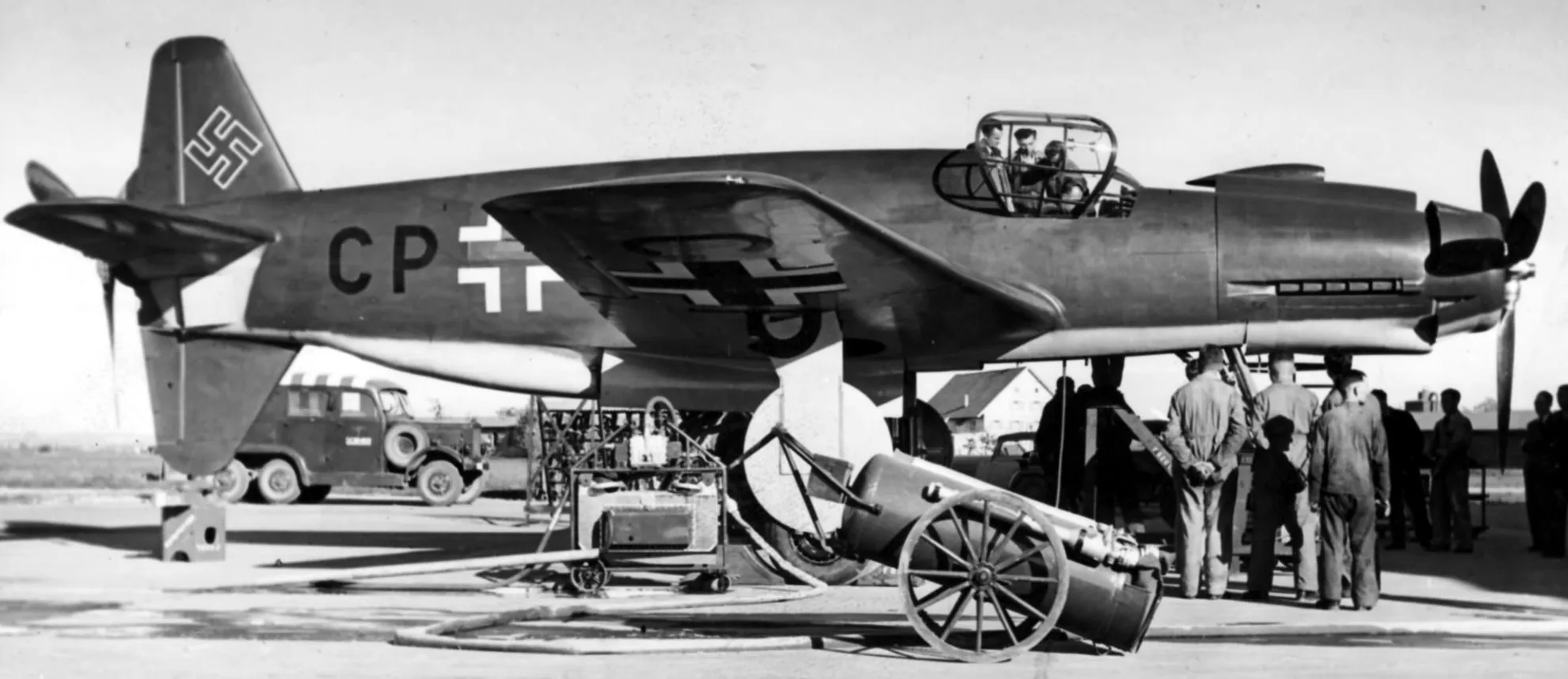
(Luftwaffe Photo)
Do 335 V1 first prototype, CP+UA, 1943.

(ETH-Bibliothek Zürich, Bildarchiv Photo)
Do 335 V1 first prototype, CP+UA, 1943.
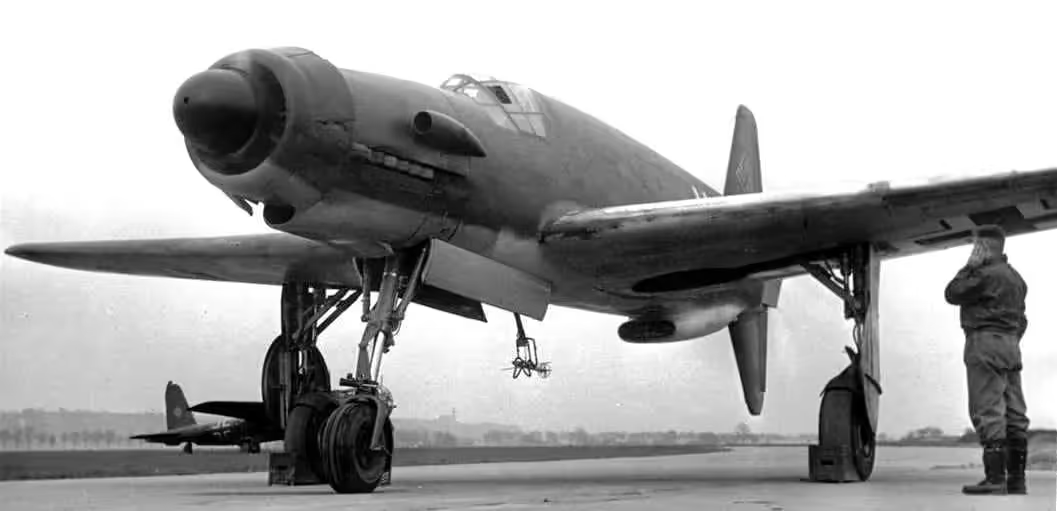
(Luftwaffe Photo)
Dornier Do 335V-2, (Wk. Nr. 230002), Stammkennzeichen CP+UB, with its engines being run up. This aircraft's rear engine caught fire and it was written off on 15 April 1944. (Luftwaffe Photo)
At least 16 prototype Do 335s were known to have flown, including V1–V12, (Wk. Nrs. 230001-230012) and Muster-series prototypes M13–M17, (Wk. Nrs. 230013-230017), on a number of DB603 engine subtypes including the DB 603A, A-2, G-0, E and E-1. The first preproduction Do 335 (A-0s) starting with (Wk. Nr. 240101), Stammkennzeichen VG+PG, were delivered in July 1944. Approximately 22 preproduction aircraft were thought to have been completed and flown before the end of the war, including approximately 11 A-0s converted to A-11s for training purposes. Dornier Do 335A-0, (Wk. Nr. 240121) or (Wk. Nr. 240161), (to be confirmed), and Dornier Do 335A-12, (Wk. Nr. 240112), captured by American forces at Oberpfaffenhoffen, were transferred to the RAF.

(Dornier Photo)
Dornier Do 335V-1 with chin oil cooler and circularmainwheel doors.
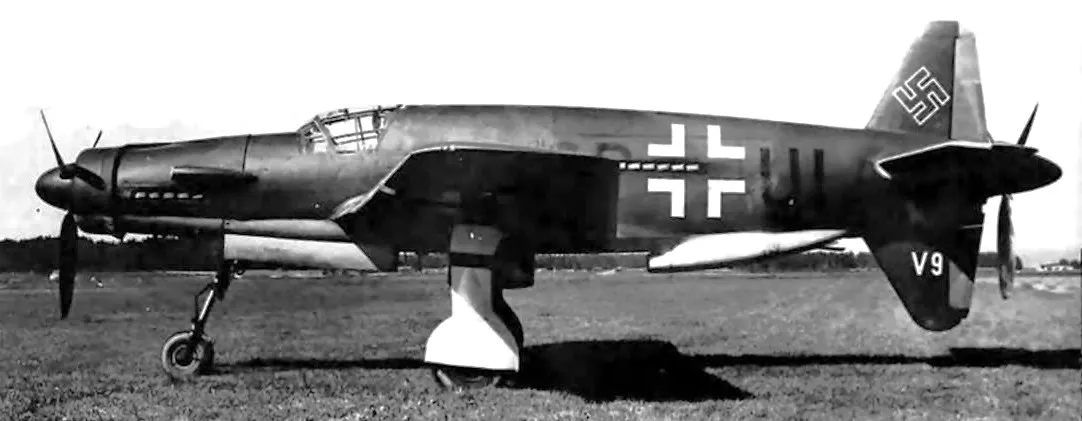
(Dornier Photo)
Dornier Do 335 V9 Wk-Nr 230009, coded CP+UI.

(Dornier Photo)
Dornier Do 335 V1 coded CP+UA.

(Luftwaffe Photo)
Dornier Do 335V-9. The Dornier Do 335 was a twin-engined fighter designed for the German Luftwaffe during the closing stages of the Second World War. The engines were arranged in a push-pull configuration, which produced a very fast aircraft. Overheating was a constant threat from the rear engine, a problem that continued throughout its development.

(Luftwaffe Photo)
Dornier Do 335 V1, coded CP+UA.

(USAAF Photo)
Dornier Do 335A-0, reported as (Wk. Nr. 240121) and (Wk. Nr. 240161), (unconfirmed), captured at Oberpfaffenhoffen, Germany by US forces. This single seat version was taken over by the RAF. It is shown here being examined by American soldiers. Designated RAF AM225, this aircraft was test flown until it was written off after a landing accident in Merville, France on 13 December 1945.
Dornier Do 335A-1, RAF AM225, had been surrendered at the Dornier Oberpfaffenhofen factory and flown to Neubiberg under US control. It was an unpainted aircraft, which had not been delivered to the Luftwaffe. It was handed over to the British authorities on 7 September and flown from Neuberg to Reims where it became unserviceable. After repairs, it was test flown at Reims on 9 and 12 December, and then flown to Marville, France on 13 December where it made a forced landing with the nose wheel retracted, and was later scrapped. The only Do 335 parts sent to the UK included a single-seat fuselage, which was also scrapped at Farnborough.

(Luftwaffe Photos)
Dornier Do 335 V11 (A-0) Wk-Nr 240111, coded CP+UL.

(Luftwaffe Photos)
Dornier Do 335 V11 (A-0) Wk-Nr 240111, coded CP+UL.


(USAAF Photos)
Dornier Do335A-12, (Wk. Nr. 240112) captured by American forces at Oberpfaffenhofen, Germany. (Wk. Nr. 240112) was traded to the RAF where it became AM223.

(USAAF Photo)
Do 335A-12, (Wk. Nr. 240112), captured by American forces at Oberpfaffenhoffen.



(RAF Photos)
Dornier Do 335A-12 Pfeil, (Wk. Nr. 240112) at Farnborough, England, summer 1945. This aircraft crashed on 18 Jan 1946. (RAF Photos)
The Do 335A-12 Pfeil, (Wk. Nr. 240112), was captured by US forces at Oberpfaffenhofen, Germany, in May 1945. RCAF Squadron Leader Joe McCarthy had traded 15 Focke-Wulf Fw 190 single engine fighters to the USAAF for this aircraft (No. 112). This aircraft had its iron cross markings removed and USAAF star and bar markings had been painted on it. Joe put the RAF roundels on the aircraft over the star, but one can still see the bar under the roundel in this photo taken at the Royal Aircraft Establishment at Farnborough in England. Designated RAF AM223, it was test flown at war’s end by RCAF S/L Joe McCarthy with the Royal Aircraft Establishment‘s Foreign Aircraft Flight at Farnborough, UK. This aircraft came to a tragic end when, during a familiarization flight on 18 January 1946 the rear engine caught fire and the elevator controls burnt through. The aircraft plunged vertically into a school at Cove, Hampshire, killing RAF Group Captain Alan F. Hards.
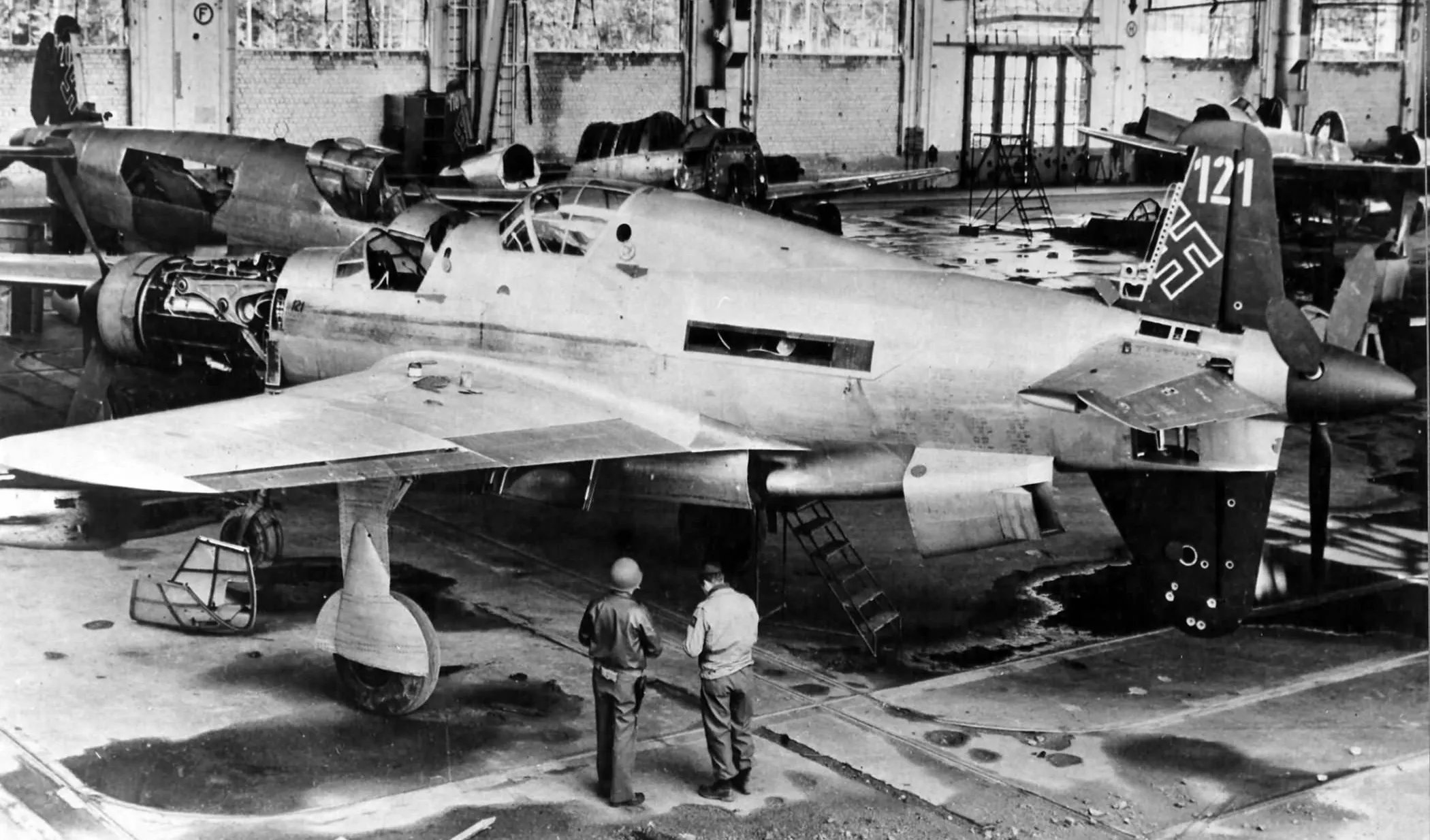
(USAAF Photo)
Do 335 A-12 “Ameisenbär” (W.kNr. 240121) at Oberpfaffenhofen. In the factory, unfinished, one of 11 aircraft built at Oberpfaffenhofen, plus 9 aircraft partially assembled, November – April 1945) and captured by American forces at Oberpfaffenhofen, Germany, May 1945. 20 Do 335A-1 aircraft included (Wk. Nrs. 240113, 240161-240170), intact, and (Wk. Nrs. 240301-240309), partially assembled. Four partially assembled Do335A-4 (of 10 aircraft scheduled for January – February 1945) were also captured at Oberpfaffenhofen, (Wk. Nrs. 240310-240313). One Do 335A-10, (Wk. Nr. 240111), which had flown in late Nov 1944 was captured.
.webp)
(USAAF Photo)
Dornier Do 335 aircraft in various states of assembly at the Donier plant at Oberpfaffenhofen, Germany, in 1945.
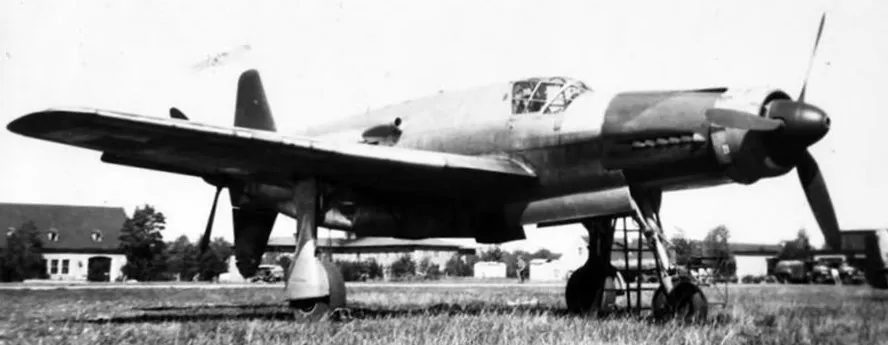
(USAAF Photo)
Captured Dornier Do 335 A-1 Pfeil, 1945.

(USAAF Photo)
Dornier Do 335 A-0 Wk-Nr 240102, coded VG+PH, captured by the US.

(USAAF Photo)
A German Dornier Do 335A-05 (Wk.Nr. 240105), coded VG+PK, in 1945. Riddled with bullet holes, 240105 was captured by the U.S troops at Lechfeld, Bavaria, Germany. Later, it was not among the aircraft taken to the United States for testing.
.webp)
(USAAF Photo)
Dornier Do 335 A-0 Wk-Nr 240105, coded VH+PK, captured by the US.
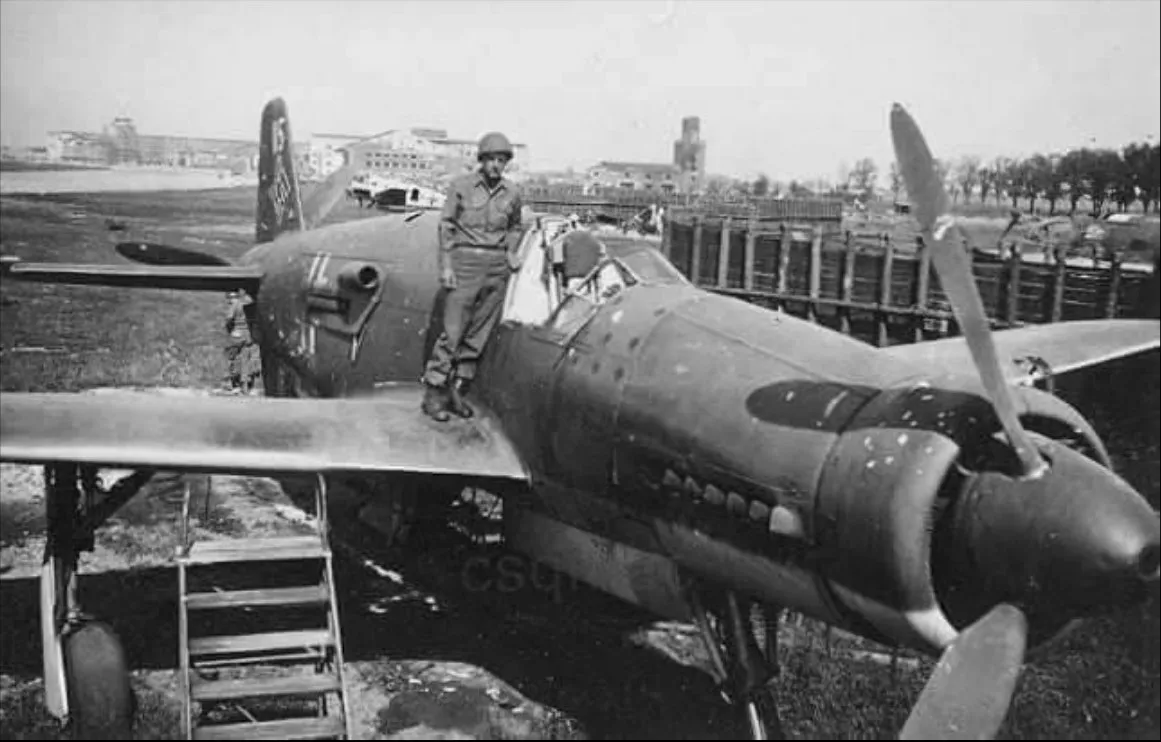
(USAAF Photo)
Dornier Do 335 A-0, possibly Wk-Nr 240105, coded VH+PK, captured by the US.

(Luftwaffe Photo)
Dornier Do 335A, 107, overhead view of a factory fresh Pfeil on the tarmac.
The A-1 version had a service ceiling of 37,400’ and the A-6 version had a service ceiling of 33,400’. The Do 335A-1 was armed with two 15-mm MG 151/15 machine guns above the nose and one 30-mm Mk 103 cannon firing through the propeller hub. The Do 335A-6 was armed with two 20-mm MG 151/20 machine guns above the nose and one 30-mm Mk 103 cannon firing through the propeller hub. The Do 335B-2 was armed with two 20-mm MG 151/20 machine guns above the nose, two 30-mm Mk 103 cannon mounted in the wings and one 30-mm Mk 103 cannon firing through the propeller hub. Avionics for the Do 335B-2 included a FuG 125a blind landing receiver and FuG 25a IFF.
.avif)
(USAAF Photo)
Captured Dornier Do 335A Pfeil (Wk.Nr. 240161). An American test pilot familiarizes himself with the controls of a USAAF-marked Dornier Do 335A Pfeil at a captured Luftwaffe airfield, surrounded by the wreckage of other German aircraft.

(USAAF Photo)
Dornier Do 335A, (Wk. Nr. 240161), USA FE-1012, later T2-1012. Junkers Ju 290 in the background at Frfeeman Field, Indiana.
As far as is known, the Pfeil never entered into combat, although US pilots reported seeing the strange aircraft in the sky during sorties over Germany, and the Erprobungskommando was forced to send aircraft into a sky which could not be guaranteed as being free of hostile aircraft. In its single-seat version it was one of the fastest piston-engined fighters ever built, with a claimed top speed of around 475-mph (765 km/h). Despite this high performance, it was the much slower two-seat night-fighter version which would probably have proved the most effective if the war had continued. Equipped with excellent radar and powerful weapons, and blessed with good visibility, combat persistence and performance, the night-fighter would have wreaked havoc against the RAF bomber streams.
Flying the Pfeil was an experience, thanks to its high performance and unusual configuration. While the performance provided an exhilarating ride for the pilot, the configuration prompted some doubts. His main concern was the ejection seat, the Do 335 being only the second production type to feature this (after the Saab J21). Before firing the seat, explosive bolts which held the upper vertical tail surface and rear propeller were fired to clear a way for the egressing pilot. Despite the ejection seat, he had to jettison the canopy manually. As another safety feature, the lower vertical tail surface was jettisonable in case a wheels-up landing was attempted. The upper tailfin and the rear propeller were equipped with explosive bolts to separate them from the fuselage to avoid impacting the pilot in the case of ejection.
When the US Army overran the Oberpfaffenhofen factory in late April 1945, only eleven Do 335A-1 single seat fighter-bombers and two Do 335A-12 conversion trainers had been completed. In his book The Big Show, French ace Pierre Clostermann claims the first Allied combat encounter with a Pfeil in April 1945. Leading a flight of four Hawker Tempests from No. 3 Sqn, RAF, over northern Germany, he intercepted by chance a lone Do 335 flying at maximum speed at treetop level. Detecting the British aircraft, the Luftwaffe pilot reversed course to evade. In spite of the Tempest’s considerable speed (equal to a North American P-51D Mustang's), the RAF fighters were not able to catch up or even get into firing position.


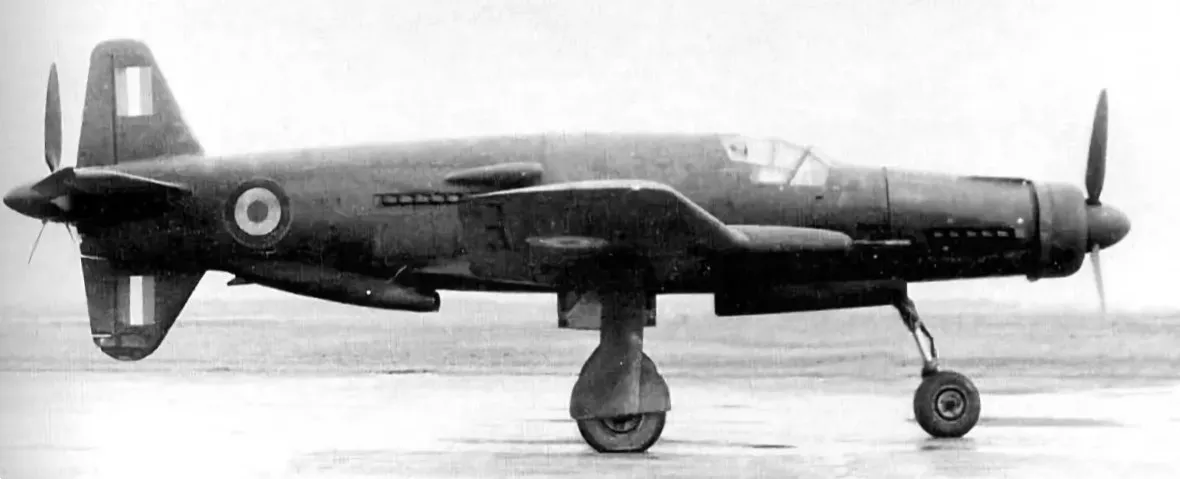

(Armée de l'Air Photos)
Dornier Do 335B-2 prototype, (Wk. Nr. 230018), ex-RP+UB, (14/18), armed with an additional pair of Rheinmetall-Borsig Maschinenkanone MK103 30-mm autocannon, transferred to France and painted in Armée de l'Air markings. (Armée de l'Air Photos)



(Armée de l'Air Photos)
Dornier Do 335V-17, B6 prototype, (Wk. Nr. 230016), coded RP+UE, No. 2, was transferred to France in the fall of 1945 and painted in French Armée de l'Air markings. It was damaged in a landing accident and written off.


(USN Photos)
Dornier Do 335A Pfeil being loaded on HMS Reaper in Cherbourg harbour, for shipment to the USA.

(USN Photo)
Messerschmitt Me 262, Dornier Do 335, Junkers Ju 338 and other aircraft preserved on the deck of HMS Reaper.
All the aircraft were cocooned against the salt air and weather, loaded onto HMS Reaper, and brought to the US where they were studied by the Air Intelligence groups of both the USAAF and US Navy.

(Friedman Field Recovery Team Photo)
Dornier Do 335A Pfeil, possibly (Wk Nr. 240161), Freidman Field, Indiana, 1945.

(USAAF Photo)
Dornier Do 335A-0 Pfeil (Arrow) (Wk. Nr. 240102), coded VG+PH, tail number 102, at Freeman Field, Indiana post war. A second Do 335A (Wk. Nr. 240161), USA FE-1012 was probably scrapped at Freeman Field in 1946.
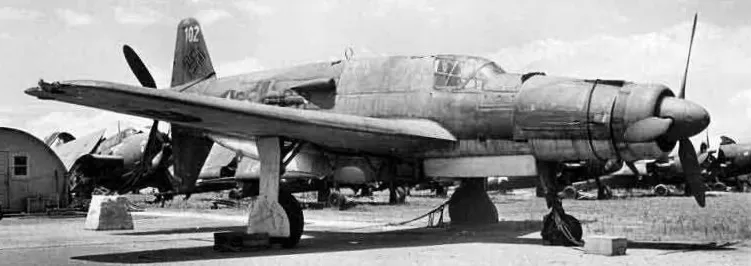

(USN Photo)
Dornier Do 335A-0, (Wk. Nr. 240102), coded VG+PH at NAS Norfolk. This aircraft went to the USN Tactical Test Division at NAS Patuxent River, Maryland where it was allocated USN (BuNo. 121447) and examined from Dec 1945 to 31 Mar 1947, then stored at NAS Norfolk until 1961. It went to the Smithsonian, and was eventually sent to Germany on 10 Oct 1974 to the original makers for refurbishment. It was displayed in Deutsches Museum, Munich for a few years and then returned to the Smithsonian. It is now on display in the Steven F. Udvar-Hazy Centre, Chantilly, Virginia.
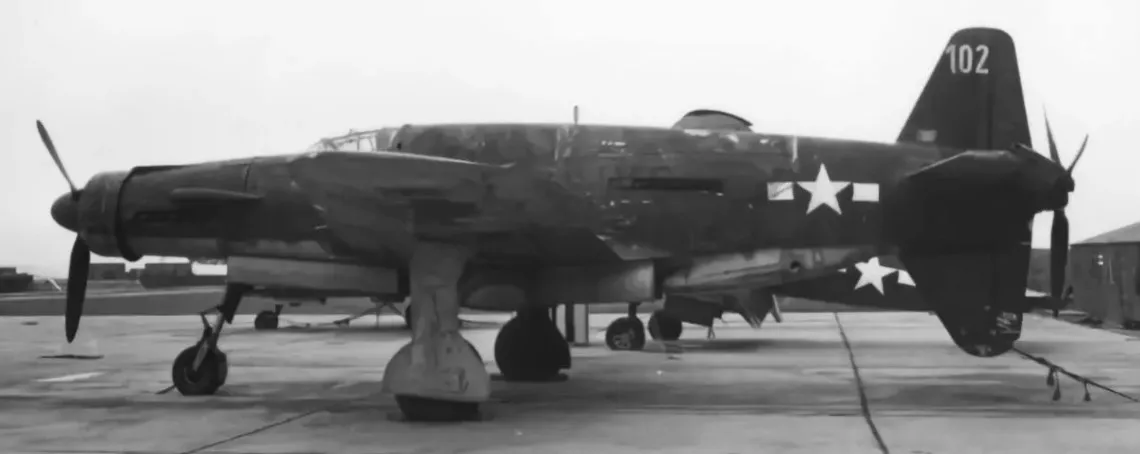
(USN Photo)
Dornier Do 335A-0, (Wk. Nr. 240102), coded VG+PH at NAS Norfolk.

(Dornier Photo)
Dornier Do 335A-02 Pfeil, (Wk. Nr. 240102), VG+PH, USN (BuNo. 121447), as restored by the Deutsches Museum.

(Ishaan Dalal Photo)
Dornier Do 335A-02, (Wk. Nr. 240102), VG+PH, USN (BuNo. 121447), on display in the National Air and Space Museum Steven F. Udvar-Hazy Center, Washington-Dulles International Airport, Chantilly, Virginia.

(Guinnog Photo)

(NASM Photo)

(NASM Photo)
Dornier Do 335A-02 Pfeil, (Wk. Nr. 240102), VG+PH, USN (BuNo. 121447), on display in the Steven F. Udvar-Hazy Centre, Chantilly, Virginia.
The Do 335A-1 is on display in the National Air and Space Museum Steven F. Udvar-Hazy Center, Washington-Dulles International Airport, Chantilly, Virginia, was the second Do 335A-0, designated A-02, with construction number (Werk-Nummer 240102) and factory registration VG+PH. It was built at Dornier’s Rechlin-Oberpfaffenhofen, Germany, plant on 16 April 1945. It was captured by Allied forces at the plant on 22 April 1945.
After checkout, it was flown from a grass runway at Oberweisenfeld, near Munich, to Cherbourg, France. During this flight, the Do 335 easily out-climbed and outdistanced two escorting North American P-51D Mustangs, beating them to Cherbourg by 45 minutes. Under the US Army Air Force’s “Project Sea Horse,” two Do 335s were shipped to the United States aboard the Royal Navy ship HMS Reaper together with other captured Luftwaffe aircraft, for detailed evaluation. This aircraft was assigned to the U.S. Navy, which tested it at the Test and Evaluation Center, Patuxent River Naval Air Station, Maryland. The other aircraft, Dornier Do 335A, (Wk. Nr. 240161), with registration FE-1012 (later T2-1012), went to the USAAF at Freeman Field, Indiana, where it was tested in early 1946. Its subsequent fate is unknown, and VG+PH is the only Do 335 known to exist.
Following Navy flight tests in 1945-48, the aircraft was donated to the Smithsonian’s National Air Museum in 1961 but was stored at NAS Norfolk until 1974. It was then returned to Oberpfaffenhofen, Germany, where the Dornier Company restored it to original condition in 1975. The return trip to Germany required an exemption under U.S. laws concerning the export of munitions. The Dornier craftsmen doing the restoration, many of whom had worked on the original aircraft, were astonished to find that the explosive charges fitted to blow off the tail fin and rear propeller in an emergency were still in the aircraft and active, 30 years after their original installation! The Do 335 was put on static display at the 1-9 May 1976, Hannover Air show, and then loaned to the Deutsches Museum in Munich, where it was on prominent display until returned to Silver Hill, Maryland, in 1986.
VG+PH can be seen today in the Steven F. Udvar-Hazy Center of the National Air and Space Museum alongside other unique late-war German aircraft that accompanied the Do 335 aboard Reaper nearly eight decades earlier, such as the only known example of the Arado Ar 234 B-2 Blitz jet reconnaissance-bomber, and the fully restored fuselage and tail surfaces of the only complete surviving Heinkel He 219A Uhu (Eagle-Owl) night fighter (the wings and engines/nacelles are still undergoing restoration).





